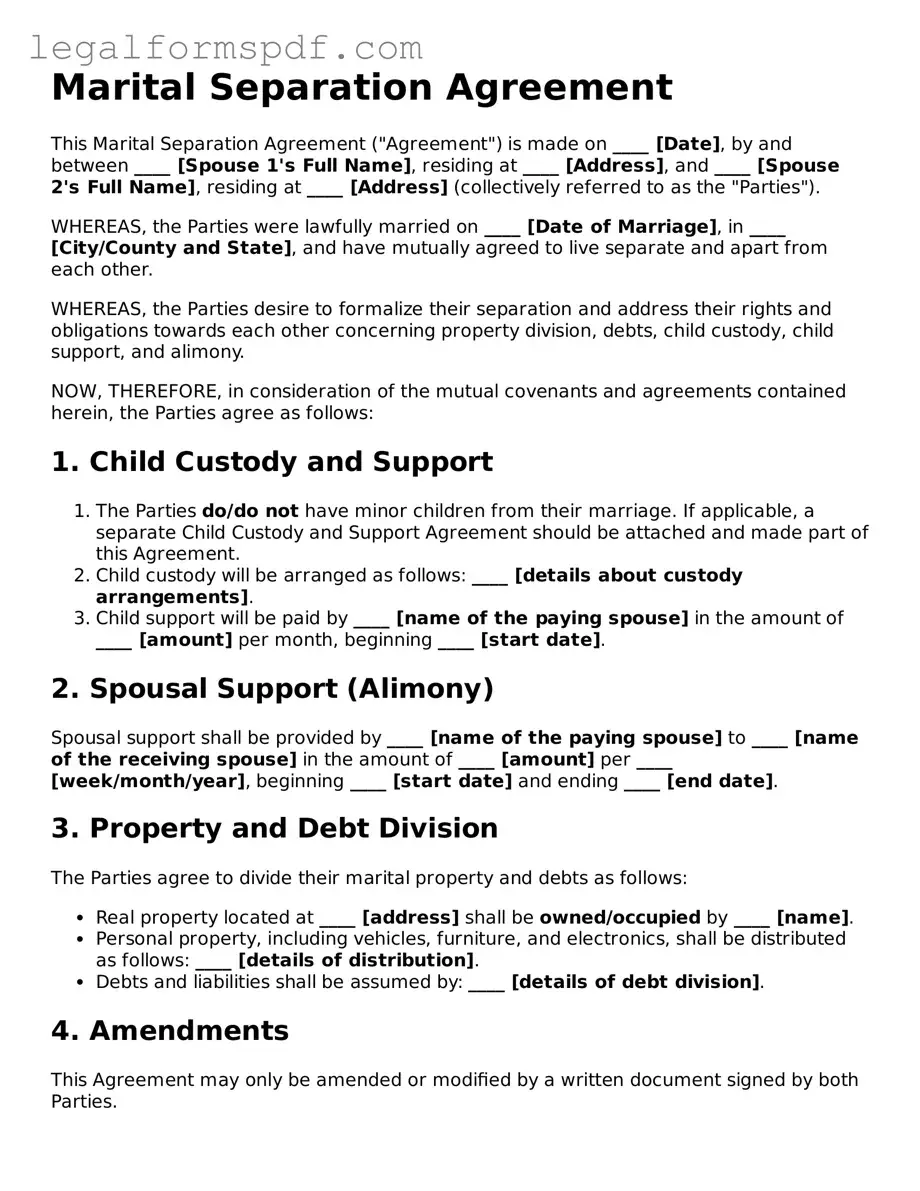What is a Marital Separation Agreement?
A Marital Separation Agreement is a legally binding document that outlines the terms and conditions agreed upon by a couple undergoing a separation. It covers various aspects such as asset division, debt responsibility, alimony, child support, and custody arrangements. The agreement provides a clear framework for the rights and responsibilities of each party, helping to avoid misunderstandings and conflicts during the separation process.
Do I need a lawyer to create a Marital Separation Agreement?
While it's not mandatory to have a lawyer to draft a Marital Separation Agreement, consulting with one can greatly benefit both parties. A lawyer can help ensure that the agreement complies with state laws, addresses all necessary topics, and provides protection to both individuals. If the separation is complex, involving significant assets, debts, or sensitive issues around child custody, legal guidance is highly recommended.
Can a Marital Separation Agreement be modified after it's signed?
Yes, a Marital Separation Agreement can be modified after it's signed, but any changes must be agreed upon by both parties. Once an agreement has been reached on the modifications, the changes should be documented in writing and ideally reviewed by a legal professional. In some cases, the revised agreement may need to be filed with the court.
Is a Marital Separation Agreement the same as a divorce?
No, a Marital Separation Agreement is not the same as a divorce. The agreement is a step taken during separation, where the couple decides to live apart and delineate the terms of their separation. A divorce, on the other hand, legally ends a marriage. While the terms set in a Marital Separation Agreement may be carried over into a divorce decree, the actual process of divorce requires additional legal steps and court approval.
What happens if one party does not comply with the terms of the Marital Separation Agreement?
If one party fails to comply with the terms of the Marital Separation Agreement, the other party has the right to enforce the agreement through legal action. The agreement is a binding contract, and non-compliance can lead to court-imposed penalties such as fines or the enforcement of specific terms through court orders. It is important to address any breaches of the agreement promptly with legal assistance.
How long does a Marital Separation Agreement last?
The duration of a Marital Separation Agreement can vary and is determined by the terms set within the agreement. Some agreements are designed to last until the couple reconciles or decides to file for divorce, while others include specific dates or conditions that end the agreement. The needs and preferences of both parties, as well as any children involved, typically influence the length of the agreement.
Can a Marital Separation Agreement cover child custody and support?
Yes, a Marital Separation Agreement can and often does include provisions for child custody and support. These sections outline who will have primary custody, the visitation schedule for the non-custodial parent, and how much child support will be paid, including how it will be paid. It's crucial for these provisions to be clear and detailed, taking the best interests of the children into account.
What should be included in a Marital Separation Agreement?
A Marital Separation Agreement should comprehensively address all aspects of the couple's separation. This includes division of property and debts, alimony or spousal support, child custody and support if applicable, insurance and healthcare coverage, and any other relevant issues. Both parties should disclose all assets and liabilities to ensure the agreement is fair and equitable.
How do we file a Marital Separation Agreement?
To file a Marital Separation Agreement, it must first be drafted, reviewed by both parties, and signed. The process for filing the agreement with the court varies by jurisdiction but usually involves submitting the signed document to the local court handling family law cases. It's advisable to consult with a legal professional to ensure the filing process is completed correctly.
Does a Marital Separation Agreement need to be notarized?
Whether a Marital Separation Agreement needs to be notarized can depend on state laws. In many jurisdictions, notarization is required to give the document legal strength and evidence that the signatures are genuine. Notarization can help prevent disputes about the validity of the agreement. It is wise to check the specific requirements of your state or consult a legal professional.
